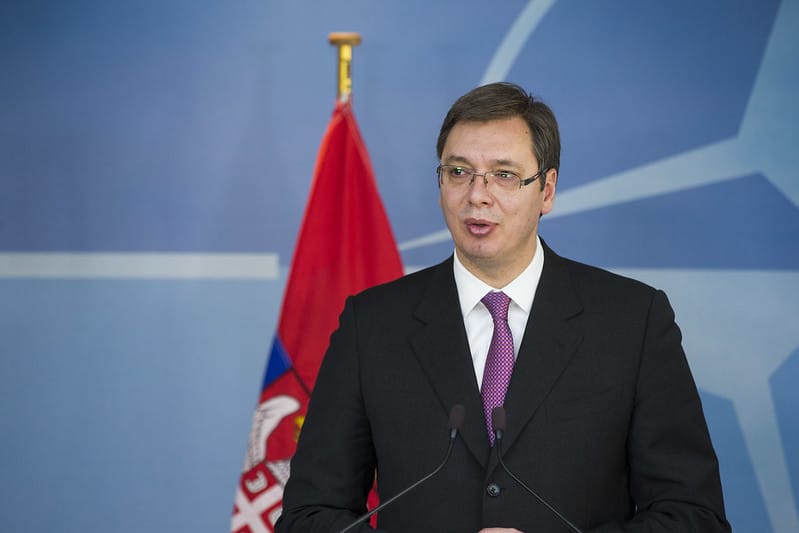Photo: Serbian President Vucic visiting NATO – NATO
A shootout between the Kosovo police and around thirty heavily armed men occurred on Sunday September 24. The incident is a new chapter in the troubled relationship between Serbia and Kosovo. Serbia considers Kosovo as part of Serbia, while Kosovo claimed independence since 2008. Relations between the two countries have always been tense, but the conflict has intensified the last couple of months due to various events in Northern Kosovo. The clash that happened this Sunday, can be seen as a continuation of the conflict getting more tense. To understand why the clash happened it is necessary to understand the background of the violence and to know what sentiments there are in the Kosovar and Serbian societies.
Violent encounter
This Sunday, the Kosovar police responded to the report of a bridge being blocked by two trucks in Banjska village, a village close to the Serbian border. Arriving at the scene, they were met with gun fire from several different positions and pelted with grenades. The shooting killed a Kosovan police officer and wounded two. After the shooting at the bridge, a group of around thirty heavily armed men forced themselves into a monastery complex in the nearby village of Leposavic. A group of Serbian worshippers visiting the monastery and the monks living there, locked themselves in to protect them from the violence. Thereafter, the Kosovar police fought the armed group and killed three of the fighters while six others were detained. The rest of the assailant group fled the monastery by foot after darkness fell. Police seized vehicles used by the group and discovered an arsenal of guns, explosives, ammunition and radio equipment.
Kosovo has now accused Serbia of sending armed troops into their territories, Kosovar president Kurti stating on X: “The murder & violence in the north is being perpetrated by these men—armed & organized professional forces in armored vehicles with no license plates. Let me restate: It is not ordinary Kosova Serb citizens but Serbian-state supported troops perpetrating these terrorist attacks”. Serbian president Vucic denied any Serbian involvement and said that the armed men were local Kosovo Serbs who no longer want to live under Kurti’s terror. He condemned the killing of the Kosovar policeman but said that it was the result of ‘brutal’ pressure on Kosovar Serbs by the Kosovan government. He also addressed the ‘hypocrisy’ of the West.
Disputed elections
The confrontation follows after tensions have risen between the two countries. One of the main reasons for this, are mayoral elections that were held in northern Kosovo this spring. After a boycott by the Serb Kosovar political parties, Albanian Kosovar mayors were elected in municipalities majority inhabited by Serbs. With a turnout of only 3,5% of the municipalities’ residents, the results of the election’s legitimacy are questionable. Despite widely supported protests by Serb Kosovars, the mayors were still sworn in. Pristina then placed special police officers in front of the municipality buildings to ensure entrance for the mayors. This caused a mayor rift between Kosovo and Serbia with Serbian President Vucic calling it an ‘occupation’, while Kosovar President Kurti called the protesters ‘ultra-nationalist right-wingers who are being paid and ordered from Belgrade and who admire despotic President Putin.’ The EU and the US urged both sides to refrain from making more accusation and asked Kosovo to stop using force.
Growing nationalism
Another cause of the rising tensions can be found in the growing nationalism in Serbian society. Serbia has always been hostile to European rapprochement and institutions since the 1998 intervention, causing less support for the EU than in other Balkan countries. In the past years, the presidents of other Western Balkan countries such as Montenegro and Croatia have accused Vucic of fueling Serbian nationalism and equated his words with the discourse in the 1990s that eventually led to war. Milo Djukanovic, former president of Croatia, for example said: “Once again, the illusion is being spread that multiethnic democracy is not possible in the Western Balkans, that it is time to create enlarged nationally and religiously homogeneous states.” Vucic appears to be doing this to create division, in order to keep support for him and his ruling party (SNS). The EU is doing too little to sanction these tactics. The Serbian tactic of nationalism works as an incubator for other forms of nationalist, nativist rhetoric in the region – as is currently the case in the Kosovo-Serbia tensions where divisive words from both sides are visible.
The EU should take stronger action against the continuing increase of nationalism in regarding Serbia and Kosovo. EU funds could be used more effectively in a conditional manner, especially in the case of Serbia. The EU must ensure that the countries remain in dialogue with each other so that a peaceful solution can be reached, where the rights of Serbian Kosovars are guaranteed. Only then does peace and possible EU membership turn into a possible reality.
Written by: Ype Verhagen



